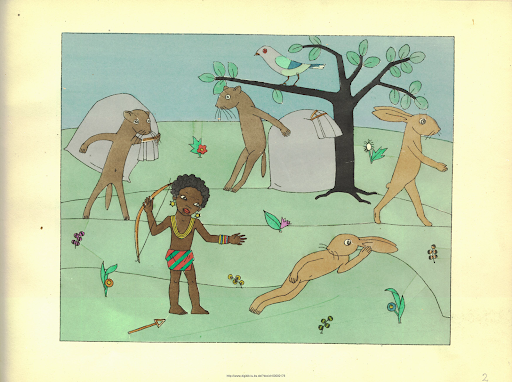Illustration by Tom Seidmann-FreudIn the beginning, none of the animals was endowed with intelligence. When they saw a hunter coming towards them who wanted to kill them, they stopped, looked at him and were shot. So our Lord sent someone who put all the senses in a sack and put it under a big tree. The weasel noticed this, ran to the hare, told him about it and said: "Brother hare, let's go there, and if you want to take the sack, I'll give you good advice." When the hare tried to carry the sack, he could not lift it and went away. The weasel tried again a second time, but the sack was too heavy. Then a dove, perched on a branch and said, "hand it over." Instead, the weasel dragged the sack away and leaned it against a tree. Then he picked it up and carried it home. When he got the sack
Topics:
Sandwichman considers the following as important:
This could be interesting, too:
Robert Vienneau writes Austrian Capital Theory And Triple-Switching In The Corn-Tractor Model
Mike Norman writes The Accursed Tariffs — NeilW
Mike Norman writes IRS has agreed to share migrants’ tax information with ICE
Mike Norman writes Trump’s “Liberation Day”: Another PR Gag, or Global Reorientation Turning Point? — Simplicius
 |
| Illustration by Tom Seidmann-Freud |
When the hare tried to carry the sack, he could not lift it and went away. The weasel tried again a second time, but the sack was too heavy. Then a dove, perched on a branch and said, "hand it over." Instead, the weasel dragged the sack away and leaned it against a tree. Then he picked it up and carried it home. When he got the sack home, he opened it and saw there was nothing inside but mind. He went to the hare to tell him about the sack and told him, "don't tell the other animals about it; I will give you a little understanding, but keep the rest in my cave. If anything else comes along, I'll give him a little too."
So the hare got some of the mind, and the weasel told him, "if you take your share with you, note the following: if you sleep during the day, open your eyes. If someone comes and thinks you would be a good bite for him to eat, he will think you are awake and go away again. But if you lie down and do not sleep, close your eyes. If someone sneaks up and wants to grab you, jump up and run into the forest. That much sense is enough for you."
The weasel kept all the rest for himself and surpasses all the animals of the field in intelligence. If someone wants to catch him, he jumps into his cave. If you dig open the cave, he escapes from behind. That's why he's called the king of the mind. Little intelligence was distributed among the other animals and they have nothing more to this day.
The above fable is from Tom Seidmann-Freud's Buch der Hasengeschichten. Tom Seidmann-Freud was Sigmund Freud's niece. Walter Benjamin mentioned her movable picture book, Der Zauberboot in one of his radio programs for children from 1930. He subsequently favorably reviewed two primers by her in Frankfurter Zeitung.
Back in the 1980s, I read everything by Walter Benjamin that had been translated into English and even embarked on a PhD program from which I expected to emerge as a "Benjamin scholar." Fortunately, my academic career was cut short by conflicting expectations held by faculty members of the department I was enrolled in.
Benjamin's radio programs for children were translated and published in 2014 and a paperback edition was published last year. I hadn't heard about it until just a while ago while I was investigating Theodor Adorno's views on Free Time and his fixation on matadors. Adorno's earlier essays brought me into the vicinity of Benjamin's essays from the same time, one of which, Program for a Proletarian Children's Theater, had been the subject of the penultimate chapter of my master's thesis, completed in 1987.
The connection between Adorno's 1969 essay on free time and Benjamin's 1929 essay on children's theater may seem tenuous. I would argue that whether or not there was any connection in Adorno's thinking is beside the point. There is a connection in mine. That connection extends back all the way to Plato and Aristotle and forward to the physicist David Bohm and to Karl Marx and Moishe Postone by way of Martin Hägglund.
This post is only an introduction. I won't develop the connections in this post but propose to do so in a series of posts that will be headlined by fables from Tom Seidmann-Freud's book of hare tales.
